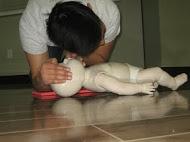Fractures are common injuries that are accompanied by extreme pain. Reported cases of fractures in children are on the rise which means that drastic measures must be implemented. In most cases, forearm fractures happen around the wrist. The bones of children are capable of healing much faster than is the case in adults. In the event that you suspect that your child has suffered from a fracture, seek medical attention.
The material posted on this page on broken bones and fractures in children is for learning purposes only. To learn to recognize and manage muscle, joint and skeletal injuries register for a first aid training program with one of our credible Canadian providers.
Children are adventurous and love engaging in physical activities. They’re bound to fall at one point while jumping, skipping or hopping. The forearm gets injured because the child will stretch an arm in the bid to support the falling body.
What Are the Symptoms of Forearm Fractures?
There are several symptoms that you’ll be watching for when dealing with fractures in children:
- Deformities particularly around the wrist
- Swelling
- Tenderness around wrist
- Difficulty in moving forearm
- Severe pain
- Numbness
What is the Diagnosis for Forearm Fractures?
In general, doctors will perform several tests that will provide the proper diagnosis. X-rays of several body parts will also be taken to reach a comprehensive conclusion. The wrist, elbow and forearm will be tested for all potential threats to be eliminated.
What Are the Ways of Treating Forearm Fractures in Children?
The treatment option used normally depends on the extent of damage. In all cases, casts are used to support the broken bones and keep them protected until they completely heal. For mild cases, the doctor may opt to using a splint / sling for holding the arm in desired position.
Surgery may be used if needed. During these procedures, the broken bones are realigned to heal together by a metallic device. Mild fractures usually heal within 4 weeks but severe cases may take up to 10 weeks to completely heal.
What Are the Long Term Outcomes?
Fractures in children usually heal faster when proper treatment is administered in time. Nevertheless, the joint will suffer from stiffness for a few weeks after the cast has been removed. Do not be alarmed because the stiffness is bound to disappear gradually even without therapy.
In severe cases where surgical procedures were implemented, the arm may become weaker. This is usually temporary but can also be permanent, especially in cases where fracture treatment was delayed. Parents are, therefore, required to monitor the physical activities of their children. Make sure that a child who suffered severe fracture does not play in large playgrounds that include things like monkey bars, for instance.
Allowing the bone to regain normal strength should be a prerogative of all family members, not only the parents. Teachers and health care providers can chip in too. Fractures in children can cause excruciating pain particularly at night, which means that someone should be standing by to attend to the patient’s needs.
Follow up sessions will be required for severe cases so that all potential dangers can be eliminated. Progress will also be measured during these meetings and any alternative treatment proving to be more successful will be considered.

